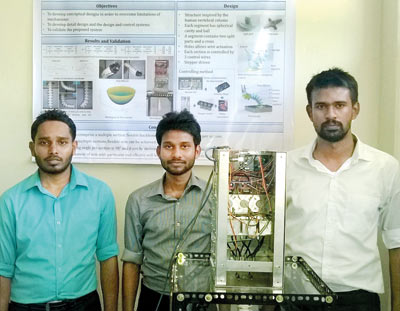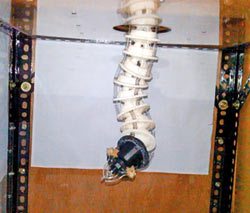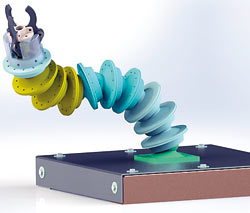Moratuwa undergrads develop novel flexible robotic arm
View(s):
From left: Gayan Sampath , Priyanga Deshapriya and Sanka Wijekoon.
Three final year students of the Department of Mechanical Engineering at the University of Moratuwa have developed a novel biomimetic flexible robot arm. This robot arm differs from traditional robot arms by being flexible instead of being rigid. Traditional robot arms are normally associated with large production factories with ample room for manoeuvring of their rigid arms. These traditional rigid robot arms meet with problems when dealing with applications in confined areas as they find it difficult to move their rigid components between small tight spaces.
Flexible robot arms is a developing area in the study of robotics for use in such application areas where moving around obstacles in tight confined spaces is needed, the department said in a media statement. This novel flexible robot arm has been developed by Priyanga Deshapriya, Gayan Sampath and Sanka Wijekoon as their final year design and research project. The project was supervised by Senior Lecturer Dr. Nirosh Jayaweera and Lecturer Mr. Asitha Kulasekera from the same department, The design of this novel flexible robot arm has been inspired by the human vertebral column.
This arm comprises three sections which can be controlled independently. Each of these sections can be bent by 90° in 3D space. Within each section a set of smaller vertebral like segments provide this flexibility. A novel joining mechanism allows the design to withstand axial twisting

Design and model of the flexible robot arm.
effects as well. This design can also be easily scaled to fit variations in the operating space by changing the number of sections and the number of segments in each section. Ultimately, using these special flexible characteristics this novel flexible robot arm can bend up to a maximum 270° with respective to its base segment.
This robot arm has been fabricated using 3D rapid prototyping technology, or what is now called as 3D printing. This type of flexible robot arms are developed for use to improve capabilities of robotic surgical systems (i.e. minimally invasive surgical procedures), improve robotic tele operation systems, help with search and rescue in collapsed structures during disasters, reduce risk of human lives while servicing and repairing tanks holding toxic and/or radioactive materials and improving efficiency of operations in the aeronautical manufacturing and maintenance industries where humans routinely have to struggle with operating in very tight confined spaces. The Department of Mechanical Engineering is planning to develop this robot arm further with an intelligent control system in the future, it said.



